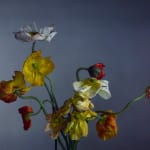-

Richard Learoyd
Poppies, 2022Ilfochrome print
Framed with Optium acrylic, designed by the artist
Paper size: 83.5 x 101.2 cm
Frame size: 127 x 109.5 cm1 in a series of 4 unique variantsAccompanied by a signed certificate from the artistFurther images
Provenance
Directly from the artistLiterature
Richard Learoyd is known for his large-scale, exquisitely detailed photographic portraits and still-life works using a specially built room-size Camera Obscura. The subject; often a person, sometimes a still life, is in a connected room separated by a lens and lit by an intense lighting system. Light is then projected instantaneously using flash and reflected through the lens, exposing an image onto direct positive paper. Learoyd creates photographs using the most basic form of photography to render a unique image which is made without any interposing negative, transparency or digital file. His process marries old and new technology: state of the art optics and Ilfochrome direct positive photographic paper to create a unique photographic experience. “I suppose people see this way of working as an alternative process,” he says, “but I see it as a very logical way to produce images, and a good use of modern materials.”His larger-than-life size portraits are monumental and contemporary, but share a 19th Century alchemist’s tradition. By employing this early method of photography, Learoyd not only achieves the illusion that his subjects might lift off the page, but he also mimics the effects of realist painting. His series "Presences," for example, derives largely from the work of the Dutch Masters, realising the faces of stoic subjects through close-up, visceral portraits.
Learoyd was born in Nelson, Lancashire, England in 1966. In 1990, he graduated from the Glasgow School of Art with a degree in fine art photography. He has shown his work at institutions such as the International Center of Photography in New York, the San Francisco Museum of Modern Art, the National Gallery in London Amongst many others. Learoyd has also been the subject of solo exhibitions at the Getty in Los Angeles, the Victoria and Albert Museum and the Mapfre Foundation in Madrid.
Publications
Richard Learoyd: Day for Night, 2015, Aperture

